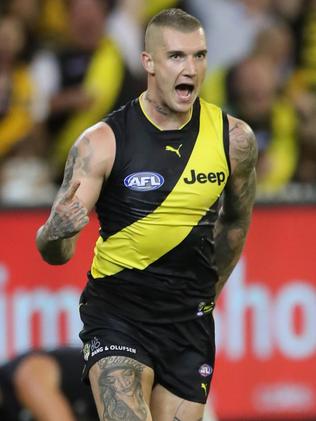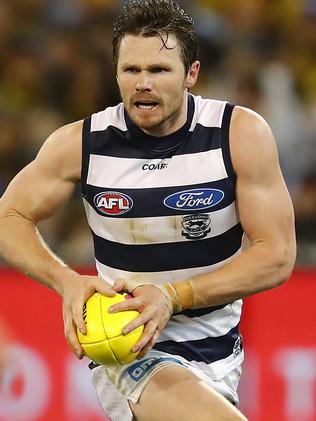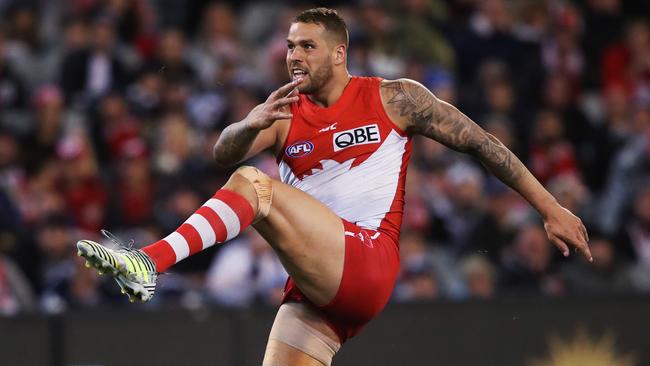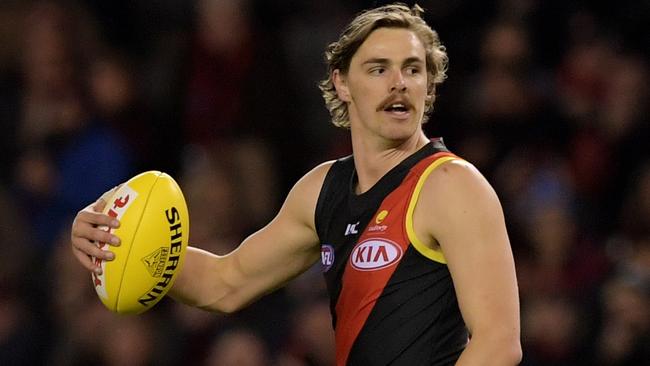One-dimensional forward lines are no longer successful in AFL, Mick Malthouse writes
THE days where the likes of Tony Lockett, Jason Dunstall and Gary Ablett kicked 100 goals a season are gone. Clubs now need an even spread and can’t afford to be one-dimensional. MICK MALTHOUSE looks at what separates teams in 2018.

MIDFIELDERS such as Patrick Dangerfield, Dustin Martin and Patrick Cripps have turned the forward line on its head.
Tall, strong and more than capable of kicking goals, they have become almost a specialist forward.
And it’s a good thing, because the day of the one-man band full-forward has passed.
I know that’s a big statement, but I can back it up with some surprising proof.
To be successful, clubs now need to have a multidimensional arsenal of goalkickers to outscore their opponent on a regular basis.
GOALKICKERS: WHO ARE THE BEST FORWARDS IN THE GAME?
TIGERS WIN: DUSTY HAS PICKED UP FROM WHERE HE LEFT OFF
DEFENDER DEBATE: IS HURLEY BETTER THAN RANCE?
Adelaide finished on top of the ladder last season with a three big and three small attack — Taylor Walker, Eddie Betts and Josh Jenkins kicked 150 goals between them. Tom Lynch and Charlie Cameron combined for 60 goals.
Compare that to North’s Ben Brown, who did a sterling job kicking 69 goals himself. But next best was Jarrad Waite with 22. The Kangaroos finished 15th.
There’s a definite pattern here.
Rather than the bygone era of Tony Lockett, Jason Dunstall and Gary Ablett kicking 100 goals for their side, the top teams now rely on multiple designated players for a similar return.
Apart from Adelaide, Tom Hawkins, Patrick Dangerfield and Daniel Menzel scored 136 goals for the second-placed Cats in 2017.


In a 1 (tall)-5 (small) forward line, Jack Riewoldt, Dustin Martin and Dan Butler landed 121 for Richmond to finish third and take out the premiership.
And rounding out the top four, GWS had Jonathon Patton, Jeremy Cameron and Toby Greene nail 135 majors.
Bottom teams could not keep pace. The Suns finished 17th with Tom Lynch almost playing a lone hand with 44 goals, while 16th-placed Carlton relied on Levi Casboult for a return of 34 goals.
I see the trend continuing this year with more key mids being used in a dangerous goalkicking position, out of the square or there abouts.
And why wouldn’t you boost your scoring options?
It is far less risky to have more players capable of kicking goals on the field, than relying mostly on one player to stay fit and consistent.
Lets compare the past to the present, or Lockett to Lance Franklin, who the most definitive full-forward of the current era.
Lockett kicked 10 or more goals in a single game on 22 separate occasions throughout his career and was the league’s leading goal kicker four times in 281 games, each time with well over 100 goals in the season.

In 271 games Lance Franklin has won four Coleman Medals, only once reaching the century. Last year he kicked 73, including finals.
Franklin, at his fittest best, is still capable of kicking 100 goals in a season.
But the Swans are using him further up field when they are in trouble, and that could happen more frequently this year.
The Swans can’t afford to be so reliant on him, because for all his hard work, he has failed to really step up in finals which has had a detrimental effect on the team.
Sydney has the systems in place to back Franklin up, they just need to endorse those players to step up and get more involved on the scoreboard.
Sam Reid is a clear target player, Luke Parker has a strong mark for a midfielder and can play like a Martin or a Dangerfield out of the goalsquare, and Isaac Heeney is a definite goal kicker.
Aside from Franklin, none of today’s key forwards, Jack Riewodlt, Betts, Hawkins or Josh Kennedy, have come close to kicking 100 goals in a season.

Bomber Joe Daniher, who I have tipped as a potential Brownlow Medallist, could play a similar role to Adam Goodes at Sydney, as a ruck and highly dangerous tall forward.
He came close to Franklin last year with 65 goals, and was backed up well by Cale Hooker with 41.
But every forward loves a bit of liberal time on the ground, so freeing Daniher up to run around the ground suits him to a tee.
He’s hard to beat one-on-one, he has a long kick, and he takes a strong mark.
He could even benefit from playing as a (scary) midfielder for a short time each term, to add to that freedom.
North’s Brown and Gold Coast forward Lynch are potentially as good as any key forward going around, but I don’t see either club making the finals this year without better back up for these players in the forward 50.
St Kilda’s Paddy McCartin should get more game time this season. He is not a Nick Riewoldt, but he can be a highly valued second or third tall option in the Saints forward line with Josh Bruce and Tim Membrey.

Jack Watts and Charlie Dixon could be a formidable forward combination at Port Adelaide, with Robbie Gray playing a cameo role out of the goalsquare.
Josh Kennedy will be a late starter for the Eagles through injury, and he will also have to overcome playing on a new, unproven home ground.
He is a lead-up forward after all, and the predictability of the Subiaco ground supplied him with the length and space he needed to be effective in the forward 50.
I played with and against some great forwards in my time, and I have coached the likes of Peter Sumich, Simon Beasley who won the Coleman in 1985, and Scott Cummings in 1999, so believe me when I say, I love watching a strong, athletic full-forward take a mark on the lead and kick a goal from 50 plus meters out.
But an individual doesn’t make a club, a premiership does, and to win one you can’t have all your eggs in one basket — unless you’re the Easter bunny.





